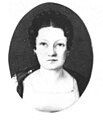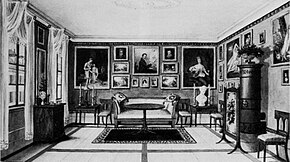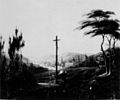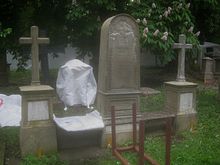Emily Reinbeck
Emilie Reinbeck (born January 20, 1794 in Stuttgart as Emilie Hartmann ; † August 15, 1846 in Stuttgart) was a Stuttgart salonnière and landscape painter . She was a close friend of Nikolaus Lenau , on whose insanity she wrote an account.
Life
childhood and adolescence
Emilie Hartmann's father August Hartmann was a teacher at the High Karlsschule in Stuttgart until its dissolution in 1793. He then held various high offices in the Württemberg administration. Her mother was Mariette Dannenberger (1766-1832), the Venice -born daughter of the court councilor and professor of commercial science (Johann) Heinrich Dannenberger (1728-1783). August Hartmann and Mariette Dannenberger married in 1792. Emilie Hartmann was born in 1794. Her godparents were the romantics Johann Heinrich Jung-Stilling and Friedrich von Matthisson . Emilie Hartmann was the eldest of the couple's four children - all girls - who survived to adulthood (Julie b. 1795, Mariette b. 1802, Charlotte b. 1808). Emilie and Julie were tutored together by a private tutor, but the writer Therese Huber , a friend of Mariette Hartmann's, also had a significant influence on their education. Emilie Hartmann's childhood friend was Huber's daughter Luise.
- Ivory miniatures of the Emilie Reinbecks family by Mariette Hartmann (married Zöppritz from 1832), around 1820
The parents' house was one of the "collecting points of spiritual life" in Stuttgart. August Hartmann's father had already shown Goethe the city when he visited Stuttgart in 1779 and had been friends with Schiller 's parents. The couple belonged to the reading group that met on Thursday evenings together with the Wangenheim, Matthisson, Schwab and Therese Huber families.
In 1809, the Minister of Education , Karl August von Wangenheim , founded a school based on Pestalozzi 's basic principles, where his children and the children of his friends were taught. The then 15-year-old Emilie Hartmann took over the lessons in the lowest grades. She stopped teaching when Wangenheim handed over the popular school to a successor. Emilie Hartmann was not able to accept his job offer, as this would have lost the previously private character of her work, which was unthinkable for a middle-class woman at the time.
marriage
On June 7, 1817, the then 23-year-old Emilie Hartmann married the writer and high school professor Georg Reinbeck , who was 28 years her senior . Reinbeck, who came from Berlin , lived in Stuttgart since 1808 after having lived in Danzig , St. Petersburg , Dresden , Weimar , Heidelberg and Mannheim . From 1810 or earlier he frequented the Hartmanns' house. His first wife died in 1816. As early as 1810, Georg Reinbeck had published a card almanac , a written explanation of the Olympian heaven of gods, which named Emilie as the addressee. It is assumed that Emilie Reinbeck was meant.
For Emilie Reinbeck it was a marriage of convenience, according to a handwritten note (she decided "to suppress the feelings of her youth and to become a loyal good wife to him"). Her childhood sweetheart, her cousin August Mayer , had been drafted into the Württemberg army while she was studying to take part in Napoleon 's Russian campaign. He had been missing in Moscow since the winter of 1812/13 .
Like Georg Reinbeck's first marriage, this one remained childless. In 1826, the Reinbecks built a house at Friedrichstrasse 14, which they shared with Emilie Reinbeck's parents. The Hartmanns lived on the ground floor, the Reinbecks on the first floor.
Emilie Reinbeck as a landscape painter
An educational trip to Switzerland in the spring of 1816, which she had undertaken before her marriage, motivated Emilie Hartmann to become a painter, and the history painter Vogel encouraged her in this. She became a student of the landscape painter Gottlob Friedrich Steinkopf , who lived in Stuttgart from 1821. He was court painter to Wilhelm I , taught at the Stuttgart Art School and is attributed to Swabian Classicism .
Emilie Reinbeck's landscape paintings corresponded to Steinkopf's style of depicting Württemberg landscapes in an Arcadian manner. Georg Kaspar Nagler's Neues Allgemeines Künstlerlexikon from 1842 described her paintings as "peaceful and idyllic appearances". Her husband Georg Reinbeck admired her sense of color and the "truth and freshness" of nature in her paintings. Writer Emma Niendorf praised: “Your landscape paintings breathe that intimate magic into which we dream. Because the artist knew how to eavesdrop on the moods of nature and thus its full poetry.”
Reinbeck's younger sister Mariette Zöppritz née Hartmann also worked as a painter. Reinbeck's pictures belong to the romantic painting of their time and follow the then established conventions. However, the pictures she presented had little success at exhibitions, which is why she soon stopped participating in them. In 2007, the culture journalist Irene Ferchl described Reinbeck's pictures as insignificant for art history.
- Pictures by Emilie Reinbeck
Queen Catherine of Württemberg , after a painting by Franz Seraph Stirnbrand , after 1819
Marie Kerner , lithograph after an 1831 drawing
Salonnière in the Hartmann-Reinbeck house
In the years that followed, the Hartmann-Reinbecksche Haus was one of the nationally important centers of cultural life in Stuttgart. The Reinbecks regularly organized tea parties, at which Swabian writers such as Ludwig Tieck , Jean Paul , Friedrich Rückert , Justinus Kerner , Gustav Schwab and Ludwig Uhland and foreign guests, including Therese Huber , Johanna Schopenhauer , Luise Duttenhofer , Sophie Schwab, Lotte Gmelin and Emma Niendorf , conversed.
Friendship with Nikolaus Lenau

One of the guests of the Hartmann-Reinbeck house from 1832 was the writer Nikolaus Lenau , who regularly stayed with the Reinbecks and admired Emilie Reinbeck in particular. Lenau and Emilie Reinbeck inspired each other. Lenau wrote poems to accompany her paintings while using motifs from his poems as motifs for her paintings. Reinbeck kept a Lenau album in which she painted pictures inspired by Lenau's poetry, including pictures on Lenau's Schilflieder , which arose from his passionate and unhappy love for Lotte Gmelin. The album is now in the Stuttgart City Archives . In his Lenau biography, the literary scholar Michael Ritter described Reinbeck as "Lenau's adviser and in a certain sense also as a substitute mother".
- Emilie Reinbeck's pictures for Lenau's poems
In 1841 Lenau fell seriously ill with scarlet fever in the Reinbeck house . Emilie Reinbeck cared for him devotedly. Three years later, while staying with the Reinbecks, he became increasingly mentally deranged after suffering a stroke and was eventually committed to a mental institution. Emilie Reinbeck recorded the experience in a shattered report. His illness would have "thrown a black veil over the rest of my life [...] that only death can take away." Lenau died three years later.
death
Emilie Reinbeck had died a year before Lenau. The burden of Lenau's illness and her care for him are said to have ruined her own health, which had been unstable from childhood. She is buried with her husband, her parents and her unmarried sister Julie Hartmann in a family grave at the Hoppenlaufriedhof in Stuttgart.
A commemorative publication with a commemorative speech by the writer Gustav Schwab and a "life outline" written by her husband was published on the occasion of her death.
Reception and impact history
Only a few letters have survived from Emilie Reinbeck's extensive correspondence, including letters to Justinus Kerner , Emma Niendorf, Karl Mayer and to her sisters Julie Hartmann and Charlotte Hartmann. Her letters to Lenau were lost. It is believed that he tore them up and burned them with other papers in a fit on October 13, 1844. On the other hand, Lenau's letters to her have survived. Anton Schlossar published them in 1896 together with Emilie Reinbeck's notes on Lenau's illness.
The Schwäbische Kronik and the Neue Freie Presse published individual letters from Emilie Reinbeck in the 1900s. Emilie Reinbeck's letters and notes are in the Württemberg State Library and in the German Literature Archive in Marbach .
In 1913, the writer Hertha Koenig , a great-grandniece of Emilie Reinbeck, published a biography novel about her, in which she portrayed Reinbeck as a "hesitant woman who was repeatedly plagued by self-doubt and doubts about her art". The novel was reprinted in 2008.
In 1929, the women's rights activist Anna Blos included her in her compilation of 15 life pictures of Swabian women, in which she focused on her friendship with Lenau.
For the cultural journalist Irene Ferchl, who recounted Reinbeck's life in a 2007 presentation by the Stuttgart Salons, her biography illustrates a typical 19th-century woman's fate, namely the "self-consciousness in the narrow role allocation". Ferchl regretted that she was only of interest to literary studies from the point of view that Lenau "went insane with her".
The literary critic Tilman Krause emphasized in 2008 that friends of literary romanticism either didn't know Emilie Reinbeck at all or only knew her as a "footnote to Lenau", but that she was a key figure in literary-artistic sociability for Swabian intellectual history.
Publications (posthumous)
- Anton Schlossar (ed.): Letters to Emilie von Reinbeck and her husband Georg von Reinbeck 1832-1844. In addition to Emilie von Reinbeck's notes. about Lenau's illness 1844-1846 . Bonz, Stuttgart 1896. ( digital copy )
- From the notes 'Lenau's illness in 1844' in the Hartmann-Reinbeck house in Stuttgart, Friedrichstraße 14 . In: Waltraud Pfäfflin, Friedrich Pfäfflin (ed.): The graves of the poets in the Stuttgart Hoppenlau Cemetery . Edition Vincent Klink, Stuttgart 2015, p. 195-200 .
literature
Nonfiction and scholarly articles
- German Biographical Archive (DBA) II 1056.39-40; III 737, 87-98.
- Emily Reinbeck . In: Hans Vollmer (ed.): General encyclopedia of visual artists from antiquity to the present . Founded by Ulrich Thieme and Felix Becker . tape 28 : Ramsden–pink . EA Seemann, Leipzig 1934, p. 346 .
- F. von Hohenhausen: Nikolaus Lenau and Emilie Reinbeck. A poet friendship . In: Westermann's yearbook of the illustrated monthly magazines . tape 34 , 1873, p. 206–214 ( google.de ).
- Adolf Wilhelm Ernst: Lenau's female figures . Published by Carl Krabbe, Stuttgart 1902, p. 131-212 .
- Bernhard Gerlach: The Literary Significance of the Hartmann-Reinbeck House in Stuttgart, 1779-1849 . Printed by Theissingsche Buchhandlung, Münster 1910, p. 61-69 .
- Anna Blos : Women in Swabia. Fifteen Life Pictures . Silberburg, Stuttgart 1929, p. 110–121 ( wlb-stuttgart.de ).
- Nikolaus Britz: Swabian women in Lenau's life and poetry. Esslinger reading from the International Lenau Society on the occasion of the poet's 175th birthday . W. Braumüller, Vienna 1977, ISBN 3-7003-0162-6 , p. 30-60 .
- Karin de la Roi-Frey: Emilie Hartmann-Reinbeck - "a Swabian salonière" . In: Swabian homeland . tape 54 , 2003, p. 451-452 .
- Tilman Krause: "That is a delicious woman". Foreword to the new edition of Hertha Koenig's Emilie Reinbeck . In: Tilman Krause (ed.): Emilie Reinbeck. Romance about Swabian Romanticism . Pendragon, Bielefeld 2008, ISBN 978-3-934872-16-5 , p. 5-21 .
- Waltraud Pfäfflin, Friedrich Pfäfflin: Emilie Reinbeck . In: The Graves of the Poets in Stuttgart's Hoppenlau Cemetery . Edition Vincent Klink, Stuttgart 2015, p. 193-200 .
- Irene Ferchl : reading circles and salons. Stuttgart's literary society in the 19th century. Stuttgart's literary society in the 19th century (conference paper) . In: Online texts of the Evangelical Academy Bad Boll . Evangelical Academy Bad Boll, Bad Boll 2007 ( ev-akademie-boll.de [PDF]).
fiction
- Hertha Koenig : Emilie Reinbeck. Romance about Swabian Romanticism . Pendragon, Bielefeld 2008, ISBN 978-3-934872-16-5 .
web links
itemizations
- ↑ Anna Blos : Women in Swabia. Fifteen Life Pictures . Silberburg, Stuttgart 1929, p. 110–121 , here: p. 110 ( wlb-stuttgart.de ).
- ↑ a b Bernhard Gerlach: The literary significance of the Hartmann-Reinbeck house in Stuttgart, 1779-1849 . Printed by Theissingsche Buchhandlung, Münster 1910, p. 61–69 , here: pp. 62–64 .
- ↑ a b Irene Ferchl: Reading circles and salons. Stuttgart's literary society in the 19th century. Stuttgart's literary society in the 19th century (conference paper) . In: Online texts of the Evangelical Academy Bad Boll . Evangelische Akademie Bad Boll, Bad Boll 2007, here: p. 9 ( ev-akademie-boll.de [PDF]).
- ↑ a b Anna Blos : Women in Swabia. Fifteen Life Pictures . Silberburg, Stuttgart 1929, p. 110–121 , here: pp. 110–111 ( wlb-stuttgart.de ).
- ↑ Irene Ferchl : Reading circles and salons. Stuttgart's literary society in the 19th century. Stuttgart's literary society in the 19th century (conference paper) . In: Online texts of the Evangelical Academy Bad Boll . Evangelische Akademie Bad Boll, Bad Boll 2007, here: p. 11 ( ev-akademie-boll.de [PDF]).
- ↑ Karin de la Roi-Frey: Emilie Hartmann-Reinbeck - "a Swabian Salonière" . In: Swabian homeland . tape 54 , 2003, p. 451-452 .
- ↑ Bernhard Gerlach: The literary significance of the Hartmann-Reinbeck house in Stuttgart, 1779-1849 . Printed by Theissingsche Buchhandlung, Münster 1910, p. 61–69 , here: pp. 61–62 .
- ↑ a b Irene Ferchl: Reading circles and salons. Stuttgart's literary society in the 19th century. Stuttgart's literary society in the 19th century (conference paper) . In: Online texts of the Evangelical Academy Bad Boll . Evangelische Akademie Bad Boll, Bad Boll 2007, here: p. 10 ( ev-akademie-boll.de [PDF]).
- ↑ Irene Ferchl : Reading circles and salons. Stuttgart's literary society in the 19th century. Stuttgart's literary society in the 19th century (conference paper) . In: Online texts of the Evangelical Academy Bad Boll . Evangelische Akademie Bad Boll, Bad Boll 2007, here: p. 12 ( ev-akademie-boll.de [PDF]).
- ↑ Irene Ferchl: Reading circles and salons. Stuttgart's literary society in the 19th century. Stuttgart's literary society in the 19th century (conference paper) . In: Online texts of the Evangelical Academy Bad Boll . Evangelische Akademie Bad Boll, Bad Boll 2007, p. 13 ( ev-akademie-boll.de [PDF]).
- ↑ Anna Blos : Women in Swabia. Fifteen Life Pictures . Silberburg, Stuttgart 1929, p. 110–121 , here: p. 111 ( wlb-stuttgart.de ).
- ↑ Emilie Reinbeck (1794 - 1846) Evening landscape, undated. In: State Gallery Stuttgart. Retrieved November 29, 2020 .
- ↑ Bernhard Gerlach: The literary significance of the Hartmann-Reinbeck house in Stuttgart, 1779-1849 . Printed by Theissingsche Buchhandlung, Münster 1910, p. 61–69 , here: p. 65 .
- ↑ Emma Niendorf: Lenau in Swabia. From the last decade of his life . 2nd Edition. Herbig, Leipzig 1855, here: pp. 161–162 ( google.de ).
- ↑ Irene Ferchl: Reading circles and salons. Stuttgart's literary society in the 19th century. Stuttgart's literary society in the 19th century (conference paper) . In: Online texts of the Evangelical Academy Bad Boll . Evangelical Academy Bad Boll, Bad Boll 2007 ( ev-akademie-boll.de [PDF]).
- ↑ Walter Scheffler: Lenau in Swabia. A documentation in pictures (= Marbacher Magazin. Special issue . Volume 5/1977 ). Schiller National Museum, German Literature Archive Marbach a. N., Marbach am Neckar 1977, p. 12 .
- ↑ Walter Scheffler: Lenau in Swabia. A documentation in pictures (= Marbacher Magazin. Special issue . Volume 5/1977 ). Schiller National Museum, German Literature Archive Marbach a. N., Marbach am Neckar 1977, p. 25-30 .
- ↑ Michael Ritter: Time of Autumn. Nicholas Lenau. biography . Deuticke, Vienna 2002, ISBN 3-216-30524-4 , p. 94 .
- ↑ Irene Ferchl, Wilfried Setzler: country outings in the romance. On the poets' footsteps through Baden-Württemberg . Silberburg, Tübingen 2006, ISBN 978-3-87407-690-6 , p. 166 .
- ↑ a b Irene Ferchl: Reading circles and salons. Stuttgart's literary society in the 19th century. Stuttgart's literary society in the 19th century (conference paper) . In: Online texts of the Evangelical Academy Bad Boll . Evangelische Akademie Bad Boll, Bad Boll 2007, p. 14–17 ( ev-akademie-boll.de [PDF]).
- ↑ Waltraud Pfäfflin, Friedrich Pfäfflin: Emilie Reinbeck . In: The Graves of the Poets in Stuttgart's Hoppenlau Cemetery . Edition Vincent Klink, Stuttgart 2015, p. 193-200 .
- ↑ Gustav Schwab, Georg Reinbeck: Memorial speech to Mrs. Emilie Reinbeck, née Hartmann. In addition to the outlines of the lives of the immortalized . Metzler, Stuttgart 1846.
- ↑ Anton Schlossar (ed.): Letters to Emilie von Reinbeck and her husband Georg von Reinbeck 1832-1844. In addition to Emilie von Reinbeck's notes. about Lenau's illness 1844-1846 . Bonz, Stuttgart 1896.
- ↑ Lenau's illness (Emilie Reinbeck's diary II). Neue Freie Presse, 1891-07-22, page 1. In: Anno. 22 July 1891, retrieved 5 December 2021 .
- ↑ Bernhard Gerlach: The literary significance of the Hartmann-Reinbeck house in Stuttgart, 1779-1849 . Printed by Theissingsche Buchhandlung, Münster 1910, p. 61–69 , here: pp. 66–67 .
- ↑ Hertha Koenig: Emilie Reinbeck . Fischer, Berlin 1913.
- ↑ Tilman Krause : "That is a delicious woman". Foreword to the new edition of Hertha Koenig's Emilie Reinbeck . In: Tilman Krause (ed.): Emilie Reinbeck. Romance about Swabian Romanticism . Pendragon, Bielefeld 2008, ISBN 978-3-934872-16-5 , p. 5–21 , here p. 9 .
- ↑ Hertha Koenig: Emilie Reinbeck. Romance about Swabian Romanticism . Pendragon, Bielefeld 2008, ISBN 978-3-934872-16-5 .
- ↑ Anna Blos : Women in Swabia. Fifteen Life Pictures . Silberburg, Stuttgart 1929, p. 110–121 ( wlb-stuttgart.de ).
- ↑ Irene Ferchl: Reading circles and salons. Stuttgart's literary society in the 19th century. Stuttgart's literary society in the 19th century (conference paper) . In: Online texts of the Evangelical Academy Bad Boll . Evangelische Akademie Bad Boll, Bad Boll 2007, p. 17 ( ev-akademie-boll.de [PDF]).
- ↑ Irene Ferchl: Reading circles and salons. Stuttgart's literary society in the 19th century. Stuttgart's literary society in the 19th century (conference paper) . In: Online texts of the Evangelical Academy Bad Boll . Evangelische Akademie Bad Boll, Bad Boll 2007, p. 9 ( ev-akademie-boll.de [PDF]).
- ↑ Tilman Krause: "That is a delicious woman". Foreword to the new edition of Hertha Koenig's Emilie Reinbeck . In: Tilman Krause (ed.): Emilie Reinbeck. Romance about Swabian Romanticism . Pendragon, Bielefeld 2008, ISBN 978-3-934872-16-5 , p. 5–21 , here 5–6 .
| personal data | |
|---|---|
| SURNAME | Reinbeck, Emily |
| ALTERNATIVE NAMES | Hartmann, Emilie (birth name) |
| BRIEF DESCRIPTION | German landscape painter, Salonière |
| BIRTH DATE | January 20, 1794 |
| PLACE OF BIRTH | Stuttgart |
| DATE OF DEATH | August 15, 1846 |
| PLACE OF DEATH | Stuttgart |



















